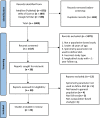Spirometry parameters used to define small airways obstruction in population-based studies: systematic review
- PMID: 35313875
- PMCID: PMC8939095
- DOI: 10.1186/s12931-022-01990-2
Spirometry parameters used to define small airways obstruction in population-based studies: systematic review
Abstract
Background: The assessment of small airways obstruction (SAO) using spirometry is practiced in population-based studies. However, it is not clear what are the most used parameters and cut-offs to define abnormal results.
Methods: We searched three databases (Medline, Web of Science, Google Scholar) for population-based studies, published by 1 May 2021, that used spirometry parameters to identify SAO and/or provided criteria for defining SAO. We systematically reviewed these studies and summarised evidence to determine the most widely used spirometry parameter and criteria for defining SAO. In addition, we extracted prevalence estimates and identified associated risk factors. To estimate a pooled prevalence of SAO, we conducted a meta-analysis and explored heterogeneity across studies using meta regression.
Results: Twenty-five studies used spirometry to identify SAO. The most widely utilised parameter (15 studies) was FEF25-75, either alone or in combination with other measurements. Ten studies provided criteria for the definition of SAO, of which percent predicted cut-offs were the most common (5 studies). However, there was no agreement on which cut-off value to use. Prevalence of SAO ranged from 7.5% to 45.9%. As a result of high heterogeneity across studies (I2 = 99.3%), explained by choice of spirometry parameter and WHO region, we do not present a pooled prevalence estimate.
Conclusion: There is a lack of consensus regarding the best spirometry parameter or defining criteria for identification of SAO. The value of continuing to measure SAO using spirometry is unclear without further research using large longitudinal data. PROSPERO registration number CRD42021250206.
Keywords: Global; Physiology; Prevalence; Respiratory epidemiology; Small airways obstruction; Spirometry.
© 2022. The Author(s).
Conflict of interest statement
None declared.
Figures



Similar articles
-
Spirometry parameters used to define small airways obstruction in population-based studies: systematic review protocol.BMJ Open. 2021 Oct 5;11(10):e052931. doi: 10.1136/bmjopen-2021-052931. BMJ Open. 2021. PMID: 34610942 Free PMC article.
-
Prevalence and clinical correlates of small airway obstruction in patients with systemic sclerosis.Clin Rheumatol. 2021 Apr;40(4):1417-1422. doi: 10.1007/s10067-020-05353-4. Epub 2020 Aug 22. Clin Rheumatol. 2021. PMID: 32827283
-
The utility of spirometry in the diagnosis of reversible airways obstruction.Chest. 1992 Jun;101(6):1577-81. doi: 10.1378/chest.101.6.1577. Chest. 1992. PMID: 1350971
-
CONTROVERSIES AND LIMITATIONS IN THE DIAGNOSIS OF CHRONIC OBSTRUCTIVE PULMONARY DISEASE.Rev Invest Clin. 2019;71(1):28-35. doi: 10.24875/RIC.18002626. Rev Invest Clin. 2019. PMID: 30810541 Review.
-
Computer-aided classification of small airways dysfunction using impulse oscillometric features: a children-focused review.Biomed Tech (Berl). 2020 Apr 28;65(2):121-131. doi: 10.1515/bmt-2018-0219. Biomed Tech (Berl). 2020. PMID: 31600137 Review.
Cited by
-
The association of spirometric small airways obstruction with respiratory symptoms, cardiometabolic diseases, and quality of life: results from the Burden of Obstructive Lung Disease (BOLD) study.Respir Res. 2023 May 23;24(1):137. doi: 10.1186/s12931-023-02450-1. Respir Res. 2023. PMID: 37221593 Free PMC article.
-
Isolated small airways obstruction predicts future chronic airflow obstruction: a multinational longitudinal study.BMJ Open Respir Res. 2023 Nov;10(1):e002056. doi: 10.1136/bmjresp-2023-002056. BMJ Open Respir Res. 2023. PMID: 37989490 Free PMC article.
-
Small airways dysfunction: The importance of utilising Z-scores to define MMEF abnormalities in clinical practice.Heliyon. 2023 Oct 6;9(10):e20744. doi: 10.1016/j.heliyon.2023.e20744. eCollection 2023 Oct. Heliyon. 2023. PMID: 37867812 Free PMC article.
-
Influence of an Exercise-Specific Face Mask on Physiological and Perceptual Responses to Graded Exercise.J Funct Morphol Kinesiol. 2024 Mar 8;9(1):48. doi: 10.3390/jfmk9010048. J Funct Morphol Kinesiol. 2024. PMID: 38535428 Free PMC article.
-
Respiratory function after 30+ years following sulfur mustard exposure in survivors in Sweden.Front Med (Lausanne). 2024 Mar 4;11:1251500. doi: 10.3389/fmed.2024.1251500. eCollection 2024. Front Med (Lausanne). 2024. PMID: 38500955 Free PMC article.
References
Publication types
MeSH terms
Grants and funding
LinkOut - more resources
Full Text Sources
Medical
Research Materials

